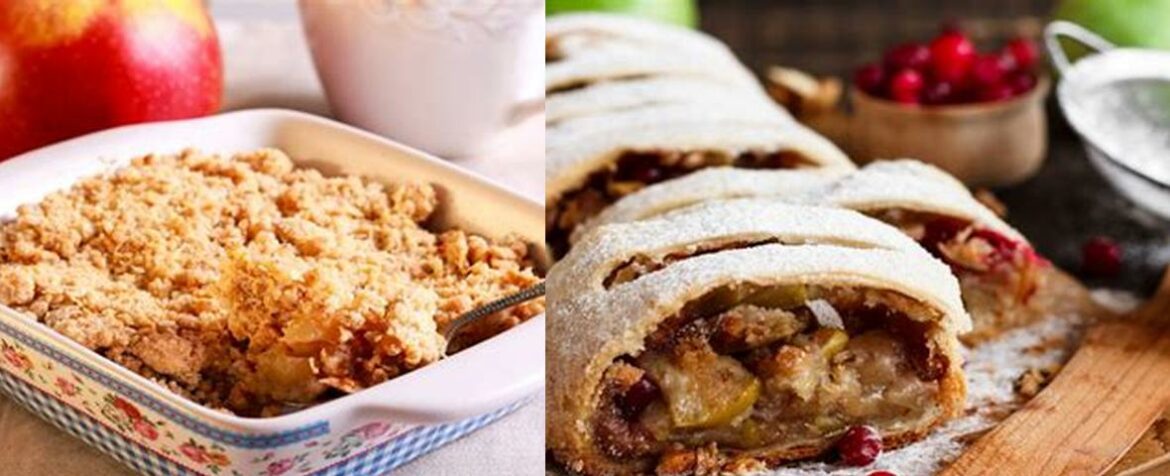Streusel vs strudel: Are you ready for a delicious journey through the world of pastries? Today, we’re diving into the delightful debate of Streusel vs Strudel. These two mouthwatering treats have captured the hearts (and taste buds) of dessert lovers everywhere. Whether you’re a fan of crumbly toppings or flaky layers, this blog post will satisfy your craving for knowledge and leave you hungry for more. So, grab a cup of coffee and get ready to indulge in the sweet rivalry of Streusel vs Strudel.
Streusel and Strudel: A Culinary Journey Through Two Beloved Pastries
From the bustling bakeries of Germany to the cozy kitchens of Austria, the world of pastries boasts a rich tapestry of flavors and textures. Among this delectable array, streusel and strudel stand out as two iconic confections, each holding a special place in the hearts of pastry enthusiasts. While both share a German heritage and a flaky pastry foundation, they diverge in their composition, fillings, and overall presentation, offering distinct culinary experiences that tantalize the taste buds.
Streusel: A Crunchy Symphony of Sweetness
Hailing from the culinary traditions of Germany, streusel, pronounced [SHTRAY-zuhl], is a crumbly topping that transforms ordinary baked goods into extraordinary delights. This delectable topping is a harmonious blend of flour, sugar, butter, and a symphony of spices, often including cinnamon, nutmeg, or vanilla. Streusel’s versatility shines through its ability to elevate a wide range of sweet treats, from humble cakes and pies to decadent muffins and cobblers. With its crunchy texture and warm, buttery flavor, streusel adds a touch of magic to every bite.
Strudel: A Flaky Masterpiece of Central Europe
Originating from the heart of Central Europe, strudel, pronounced [SHTROO-duhl], is a layered pastry that has captured the world’s imagination with its paper-thin dough and enticing fillings. This culinary masterpiece begins with a delicate dough crafted from flour, water, salt, and a touch of oil or butter. This dough is then stretched and folded with meticulous care, creating an intricate web of layers that encases a symphony of flavors. Traditional strudels are filled with a vibrant array of fruits, such as apples, cherries, and plums, along with a sprinkling of nuts, such as almonds or walnuts, and a hint of vanilla and lemon zest. The result is a harmonious blend of tartness and sweetness, wrapped in a flaky embrace.
A Tale of Two Textures: Crumbly vs. Flaky
Streusel and strudel embark on a textural journey that sets them apart. Streusel, with its coarse and crumbly nature, offers a delightful crunch in every bite. Its chunky pieces add a tactile element that contrasts beautifully with the smooth fillings beneath. Strudel, on the other hand, showcases its flaky layers, each one delicately folded to create a symphony of textures. The thin and crispy pastry yields to reveal the tender filling, creating an irresistible mouthfeel that leaves a lasting impression.
A Culinary Canvas for Diverse Flavors and Pairings
The versatility of streusel and strudel extends beyond their individual characteristics, as they both serve as culinary canvases for a symphony of flavors. Streusel’s crunchy sweetness pairs harmoniously with warm fruit compotes, creamy desserts, tart yogurt, and hearty oatmeal. Its warm, comforting flavor adds a touch of indulgence to any breakfast or dessert. Strudel, with its flaky layers and diverse fillings, shines as a standalone pastry or as a base for individual desserts. Its sweet variations, such as apple strudel, are perfect for a classic treat, while savory fillings, such as spinach and feta, offer a delightful twist.
A Legacy of Sweetness: Streusel and Strudel Through the Ages
Streusel and strudel have etched their names in the annals of culinary history, becoming beloved pastries that transcend time and borders. Streusel, a German classic, is a staple in bakeries and homes across the country. Its simple yet delectable flavor has made it a favorite topping for cakes, pies, and crumbles. Strudel, an Austrian specialty, has gained worldwide recognition for its intricate layers and mouthwatering fillings. Its apple-filled version, known as apfelstrudel, is a symbol of Austrian culinary heritage and a cherished treat around the globe.
Conclusion: A Symphony of Flavors and Textures
Streusel and strudel, two culinary gems with distinct personalities, offer a world of flavors and textures that captivate the senses. Streusel’s crumbly sweetness and strudel’s flaky embrace create a symphony of culinary delights. Whether enjoyed as a standalone pastry or as an enhancement to other desserts, these confections have earned their place in the hearts of pastry lovers everywhere. As we savor the unique charms of streusel and strudel, we embark on a journey of culinary exploration, discovering the rich tapestry of flavors and textures that make these pastries so irresistible.
FAQ about Streusel Vs Strudel
Q: What is the difference between streusel and strudel?
A: Streusel is coarse and crumbly, offering a delightful crunch, while strudel showcases flaky layers that reveal a tender filling.
Q: Where do streusel and strudel originate from?
A: Streusel is a German classic, while strudel is an Austrian specialty.
Q: How are streusel and strudel commonly used in baking?
A: Streusel is a favorite topping for cakes, pies, and crumbles, while strudel is often enjoyed as a standalone pastry or as an enhancement to other desserts.
Q: What is the signature version of strudel?
A: The apple-filled version of strudel, known as apfelstrudel, is a symbol of Austrian cuisine.
Q: What flavors and textures do streusel and strudel offer?
A: Streusel offers a crumbly sweetness, while strudel provides a flaky embrace, creating a symphony of culinary delights.
Q: Why are streusel and strudel beloved by pastry lovers?
A: Streusel and strudel offer a world of flavors and textures that captivate the senses, earning their place in the hearts of pastry lovers everywhere.


